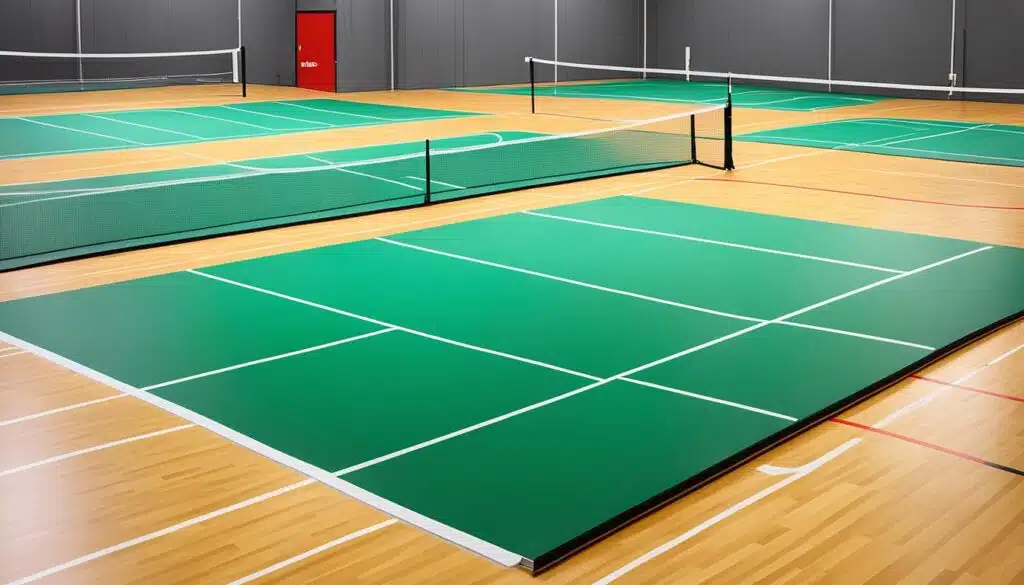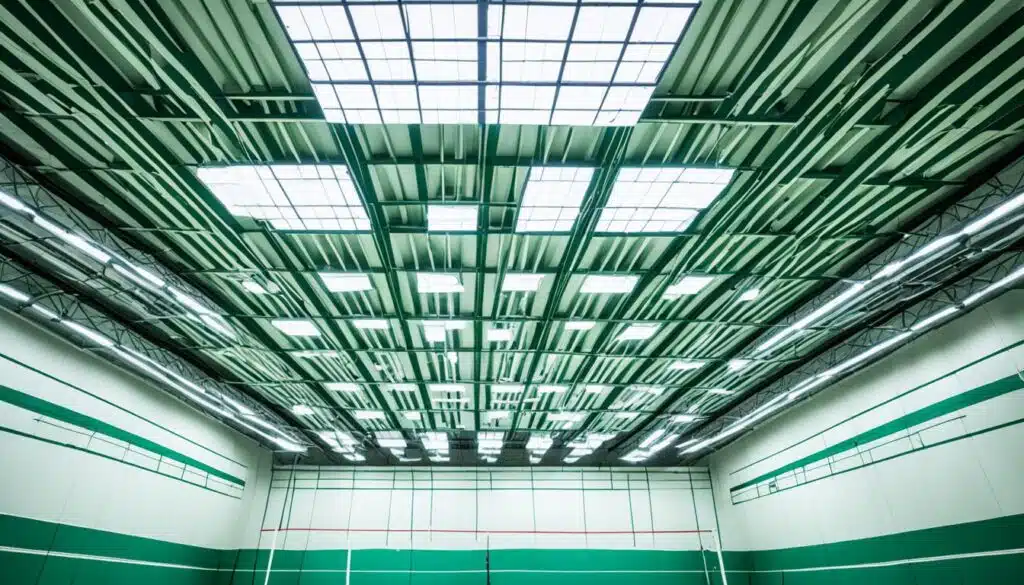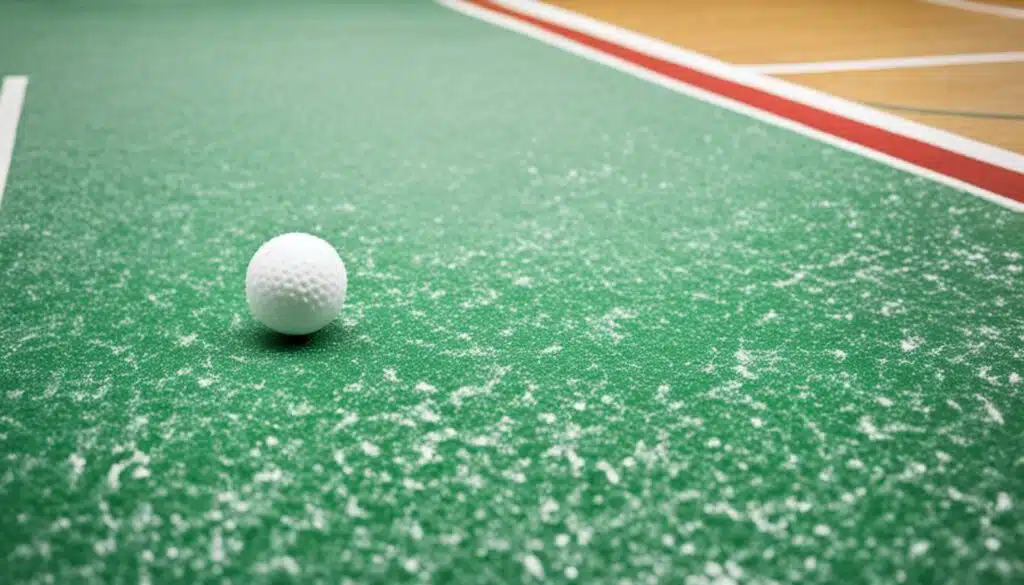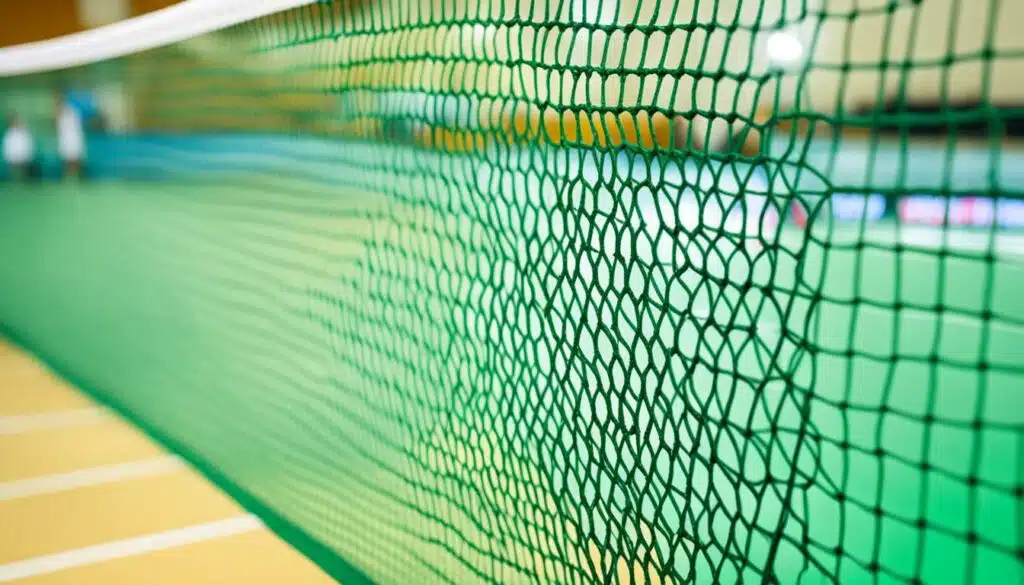Indoor badminton courts are really important. They let players practice all year, no matter the weather. The courts give a controlled space for players to get better at the game. This includes learning new skills and tactics.
We’ll look into what makes indoor badminton courts work well. This means the size, the ground you play on, the lights, and how they keep you safe. It also covers how to take care of the court. Whether you play a lot or are just getting into the sport, this guide has what you need.
Key Takeaways : Indoor Badminton Courts For Players
- Indoor badminton courts offer a controlled environment for year-round practice and competition.
- Court dimensions, surface materials, lighting, and safety features are crucial for optimal playing conditions.
- Proper maintenance of indoor badminton courts ensures longevity and consistent playing experience.
- Understanding the technical aspects of indoor court design can help players improve their performance.
- Choosing the right indoor badminton court can enhance the overall experience for both players and spectators.
Understanding the Importance of Badminton Court Dimensions
The size of a badminton court is very important. It shapes how the sport is played. The precise measurements affect player movements, their positions, and how they make their shots.
Standard Court Measurements for Singles and Doubles Play
A singles court is 13.4 meters long and 6.1 meters wide. A doubles court is a bit wider at 8.23 meters. These dimensions set the stage for the game. They impact how players cover the court and make choices.
| Court Type | Length (meters) | Width (meters) |
|---|---|---|
| Singles | 13.4 | 6.1 |
| Doubles | 13.4 | 8.23 |
Impact of Court Size on Game Strategy and Player Movement
The court’s size changes how the game flows. A small court in singles makes the game quick. Players need to move fast and think on their feet. But, in doubles, a bigger court means a broader game. Players cover more ground and predict each other’s moves.
Knowing the court’s size is key for players. It helps them strategize, move well on the court, and adjust their game for singles or doubles.
“The court size can significantly impact the pace, rhythm, and overall dynamics of a badminton game, requiring players to adapt their techniques and decision-making accordingly.”
Also Read : Exploring The World Of Retro Gaming
Exploring Different Surface Materials for Indoor Badminton Courts

Choosing the right surface for indoor badminton courts matters a lot. Wood has been a top pick for its smoothness and toughness. But lately, materials like PVC and acrylic are also popular. These materials are chosen for their better performance and lower upkeep needs.
Wood vs. Synthetic Flooring: Pros and Cons
Wood and synthetic floors have their pros and cons for badminton courts. Wooden floors give a classic vibe but need more care. They might not absorb shock as well as synthetics. On the other hand, synthetic surfaces are often safer, easier to clean, and better at cushioning falls.
- Wooden floors look classic but need more care and might not absorb shock as well.
- Synthetic materials, like PVC and acrylic, are usually safer, easier to clean, and better at reducing injuries from falls.
- Your pick between wood and synthetic floors depends on your budget, how much care you can provide, and what the players need and want.
Choosing the best court surface is key for a great time and safety in badminton. By looking at the pros and cons of each material, managers and players can choose wisely. This way, they can pick what’s best for everyone involved.
“The playing surface is the foundation of a great indoor badminton court. It must provide excellent grip, cushioning, and durability to ensure a safe and enjoyable experience for players.”
Also Read : Future Trends In Gaming: Discovering The World Of Cross Platform Games
Mastering the Art of Badminton Court Markings

Proper court markings are key to a fair badminton game. The badminton court is split into areas, each with its own rules from the Badminton World Federation (BWF). Players need to know these markings well to play correctly and keep the game fair.
Boundary Lines and Service Courts
The boundary lines show the edges of the court and where you can play. Inside, you’ll find the service courts, which are for serving and rallying. A center line then splits the court in half.
- The short service line is key, marking where a serve should land at least.
- The long service line shows the farthest point a serve can land to still be good.
- The net line marks the service courts’ boundary, running parallel to the net.
Knowing these court markings well helps players plan their moves. They can serve right and play fair and hard.
“Proper court markings are the foundation of a well-regulated badminton game, ensuring fairness and adherence to the sport’s rules and regulations.”
The Badminton World Federation sets the rules for court markings. Players must know the boundaries and center of the court. This helps them play smart and focused within the right areas.
Also Read : Fireside Tactics: Winning Strategies For Free Fire Gaming
The Crucial Role of Proper Lighting in Indoor Badminton Courts

Proper lighting is key in indoor badminton court design. It affects how well players can see and stay safe. The right light helps minimize glare and shadows. This means players can see the shuttlecock clearly and react fast.
A well-designed lighting system covers the court with brightness. It caters to the game’s quick moves. Good lighting enhances playing and keeps players safe from accidents.
- Evenly Distributed Illumination: Evenly distributed light removes dark spots and shadows. These can make it hard for players to see clearly.
- Glare Reduction: The system should cut down on glare. Less glare means players’ eyes won’t get tired and they can see better on the court.
- Color Rendering: Use lights that show the true colors of the shuttlecock and the court. This makes the game better for players.
- Lumen Output: Lights should give off enough brightness, measured in lumen, so players can track the shuttlecock and make accurate shots.
| Lighting Factors | Importance for Indoor Badminton Courts |
|---|---|
| Uniform Illumination | Stops shadows and makes visibility even across the court. |
| Glare Reduction | Lessens eye strain and betters player safety. |
| Color Rendering | Improves how players see the shuttlecock and court. |
| Sufficient Lumen Output | Gives enough lighting for players to follow the shuttlecock well. |
Proper lighting makes indoor badminton safer and more fun. It boosts visibility and lowers the chance of accidents.
“Proper lighting is essential for the safety and performance of badminton players in indoor courts. It ensures that players can clearly see the court and the shuttlecock, allowing them to make accurate shots and react quickly to the fast-paced game.”
Also Read: Dominating The Competition: Exploring The CLX Gaming Pc Series
Indoor Badminton Courts For Players: Ensuring Optimal Playing Conditions

Indoor badminton courts need careful design to meet players’ needs for training and fun. Two key things to think about are the ceiling height and the court’s surroundings.
Ceiling Height Requirements for Overhead Shots
For indoor badminton, a high ceiling is critical. It has to be tall enough so players can hit overhead shots without anything in the way. Ideally, the ceiling should be at least 9 meters high.
This height gives players room to hit all kinds of shots, like power smashes. It helps them feel confident in their game.
Surrounding Area Considerations for Spectators and Amenities
The area around the court is just as important. It should have space for players to move safely and for spectators to sit and watch. Also, it needs room for changing, storing equipment, and any other amenities.
- Seating for spectators: Make sure there are seats for spectators to enjoy watching games and tournaments.
- Changing rooms: Players need a place to change and get ready, with lockers and showers.
- Storage for equipment: A space to keep rackets, shuttlecocks, and other gear is essential for a tidy space.
Getting these aspects right makes the indoor badminton court better for players. It also helps make the sport more enjoyable for those watching. Plus, it can boost the sport’s popularity.
Also Read : Exploring The Top 10 Best Retro Games Of All Time
Safety First: Injury Prevention in Indoor Badminton Courts

Keeping indoor badminton players safe is super important. The way these courts are designed and built matters a lot. They should have special floors and enough space around them to protect players.
Shock-Absorbing Flooring and Surrounding Space
Indoor badminton court floors help prevent injuries. They’re often made of things like rubber to lessen the impact on players’ bodies. These floors make it safer for players to jump and move without getting hurt.
The area around the court is key too. There should be enough space so players don’t hit walls. This space lets players move freely to hit shots without risk.
- Using materials like rubber or special floors helps protect players from harm
- Proper space around the court prevents players from running into things
- Making indoor badminton courts safe is very important
Indoor courts are made safer when these key features are in place. Having good floors and enough room to move keep players safe. This makes sure badminton lovers can play without getting injured.
“Investing in safety features is not just about protecting players; it’s about creating an environment where they can fully immerse themselves in the sport and reach new heights of performance.”
Maintaining Indoor Badminton Courts: Best Practices
Keeping an indoor badminton court in top shape is key. It ensures every game is safe and fun. The type of surface affects how you need to care for it.
Cleaning and Care for Different Court Surfaces
Wooden floors need a bit more work. They should be swept and mopped often. Every so often, they’ll need a deep clean. This keeps the floor looking nice and stops it from getting damaged.
Synthetic courts are easier. Just sweep and mop them regularly. Deep cleaning is simpler and doesn’t take as long. This type of court is more forgiving when it comes to care.
Always listen to what the maker says about cleaning. Good care makes the court last longer. It also makes the game more fun, and everyone safer while playing.
- Regularly sweep and mop the court surface to remove dirt and debris.
- Avoid using harsh chemicals or abrasive cleaning tools that could damage the court surface.
- Schedule periodic deep cleaning or refinishing as recommended by the manufacturer.
- Inspect the court regularly for any signs of wear or damage, and address issues promptly.
“Maintaining the optimal condition of an indoor badminton court is crucial for ensuring a consistent and safe playing experience.”
Stick to these steps for keeping your badminton court perfect. This way, everyone who plays can have a great time. It doesn’t matter if you’re new to the game or a seasoned player.
Choosing the Right Net for Indoor Badminton Courts

Setting up an indoor badminton court means choosing the right net is key. This piece of equipment is vital for following the regulations set by the Badminton World Federation (BWF). It also affects how the court looks and plays.
The BWF states the net should be 1.55 meters (5.18 feet) high at the edges and 1.524 meters (5 feet) high in the middle. The net must cover the full width of the court, about 20 feet (6.1 meters). It’s important to pick a net that fits these sizes. This keeps the game fair and gives players a consistent feel on the court.
There’s more to consider than just the net’s size. The net’s material, how long it lasts, and its quality all matter. Players and owners might also care about how the net looks. They could want it in a certain color or design, or with tension ropes for a better playing surface.
| Net Characteristic | Importance |
|---|---|
| Height | Must meet the BWF standard of 1.55 meters (5.18 feet) at the edges and 1.524 meters (5 feet) at the center. |
| Width | Should span the entire width of the court, typically 20 feet (6.1 meters). |
| Material | Durable and suitable for the court’s surface and playing conditions. |
| Design Features | Aesthetic preferences, such as color, transparency, and tension ropes. |
Picking the right badminton net means thinking about how it works and what you like. A net that follows BWF rules and fits well with the court design ensures players have a great game. Plus, think about the court’s size and how well it’s lit for the best badminton experience.
“The badminton net is the heart of the court, dividing the playing area and setting the stage for an exhilarating match. Choosing the right net is crucial for both regulatory compliance and creating an optimal playing environment.”
Also Read : Roblox Gaming Community: Connecting With Players Worldwide
Conclusion
Knowing how to build indoor badminton courts lets both players and owners get the most from these spaces. It’s about putting in the right details and checking the costs. Plus, it’s important to follow rules set by the Badminton World Federation closely. Doing all this helps create the best place to play.
If you’re thinking about a new indoor badminton court or want to make your current one better before June 2024, you’re in the right place. We’ve given you tips and info to help you choose wisely. Remember, paying close attention to the small stuff is key. This ensures your court will be top-notch for both serious games and just for fun. It’s all about enjoying playing badminton in a safe and dedicated spot.
Ready to take on your indoor badminton court project? Begin by jotting down what you need and figuring out the cost. Keep in mind, your court can serve more than just badminton. It can become a hub for various sports, meeting the community’s diverse interests.
FAQs
Q: What are the different types of badminton courts available?
A: There are primarily two types of badminton courts – indoor and outdoor. Indoor courts are typically found in sports complexes or dedicated badminton facilities, while outdoor courts can be set up in open spaces like parks or backyards.
Q: Where can I find a badminton court near me?
A: You can typically find indoor badminton courts at sports complexes, community centers, or badminton clubs in your area. Outdoor courts may also be available in public parks or recreational areas.
Q: What do I need to know about badminton courts before playing?
A: Before playing on a badminton court, it’s important to understand the dimensions, boundaries, and playing surfaces of the court. Familiarize yourself with the rules and regulations to ensure a successful game.
Q: How can I install a badminton court for personal use?
A: For outdoor use, you can set up a makeshift badminton court in your backyard with a net, boundary lines, and appropriate flooring. Indoor courts require more specialized equipment and space, typically found in sports facilities.
Q: What are the top 10 badminton courts in the world?
A: The top badminton courts in the world are often found in professional sports venues and training facilities. These courts are designed to meet international standards and provide optimal playing conditions for competitive players.
Q: Are indoor and outdoor badminton courts easy to maintain?
A: Indoor badminton courts are usually easier to maintain as they are protected from external elements. Outdoor courts may require regular cleaning, maintenance of the playing surface, and protection from weather conditions.
Q: Is badminton considered a professional sport?
A: Yes, badminton is a professional sport played at elite levels in international competitions like the Olympics and World Championships. Professional players often train and compete on specialized badminton courts with professional-grade equipment.
Source Links
- https://www.pinterest.com/pin/1-unlock-the-secrets-of-dominating-in-badminton-with-smash-and-lift-techniques-learnbadminton-youtube-in-2024–676314069070474374/
- https://connect2playsports.com/sports-fitnessblog/badminton-court-respect-unwritten-rules/
- https://indiasportsfloorings.com/essential-guide-to-badminton-court-construction/
